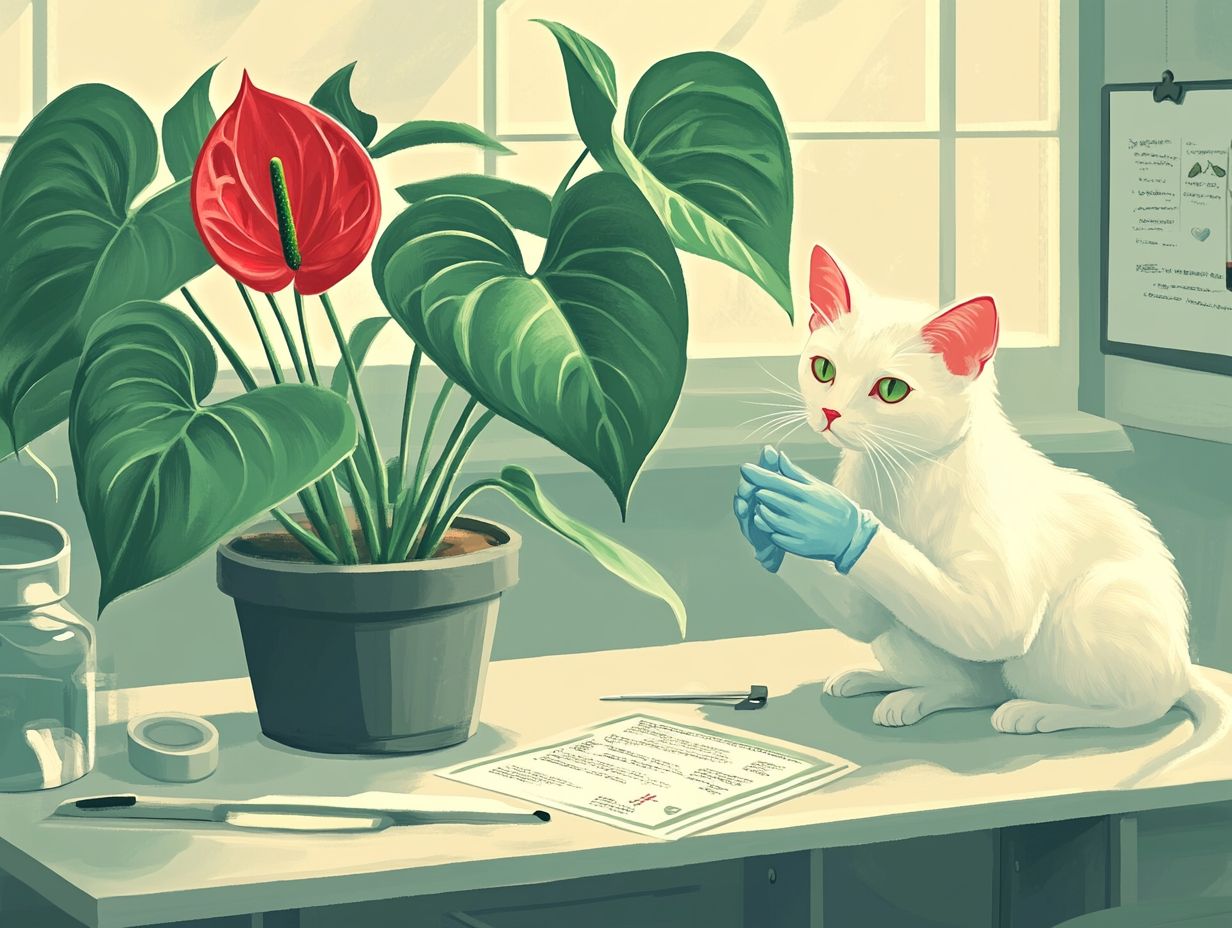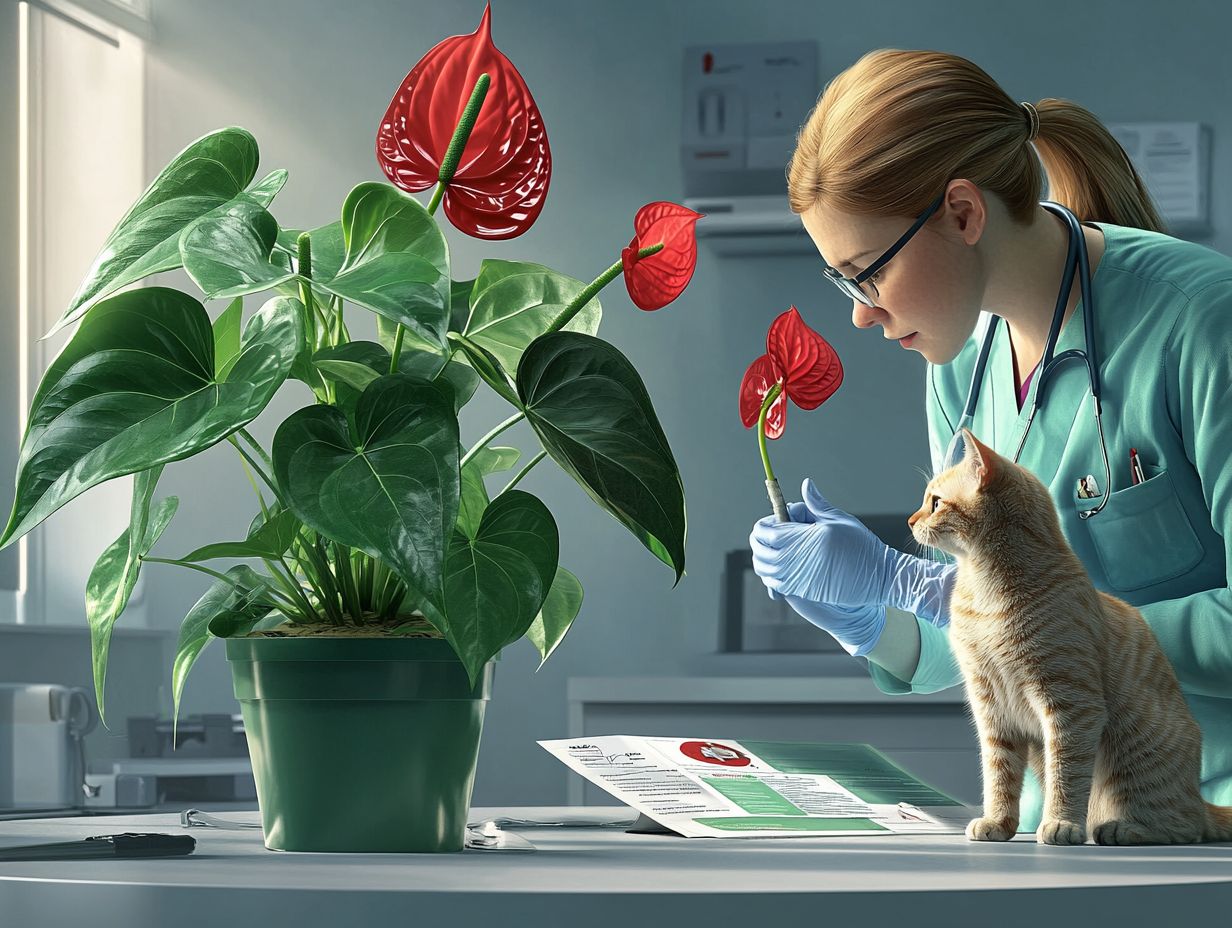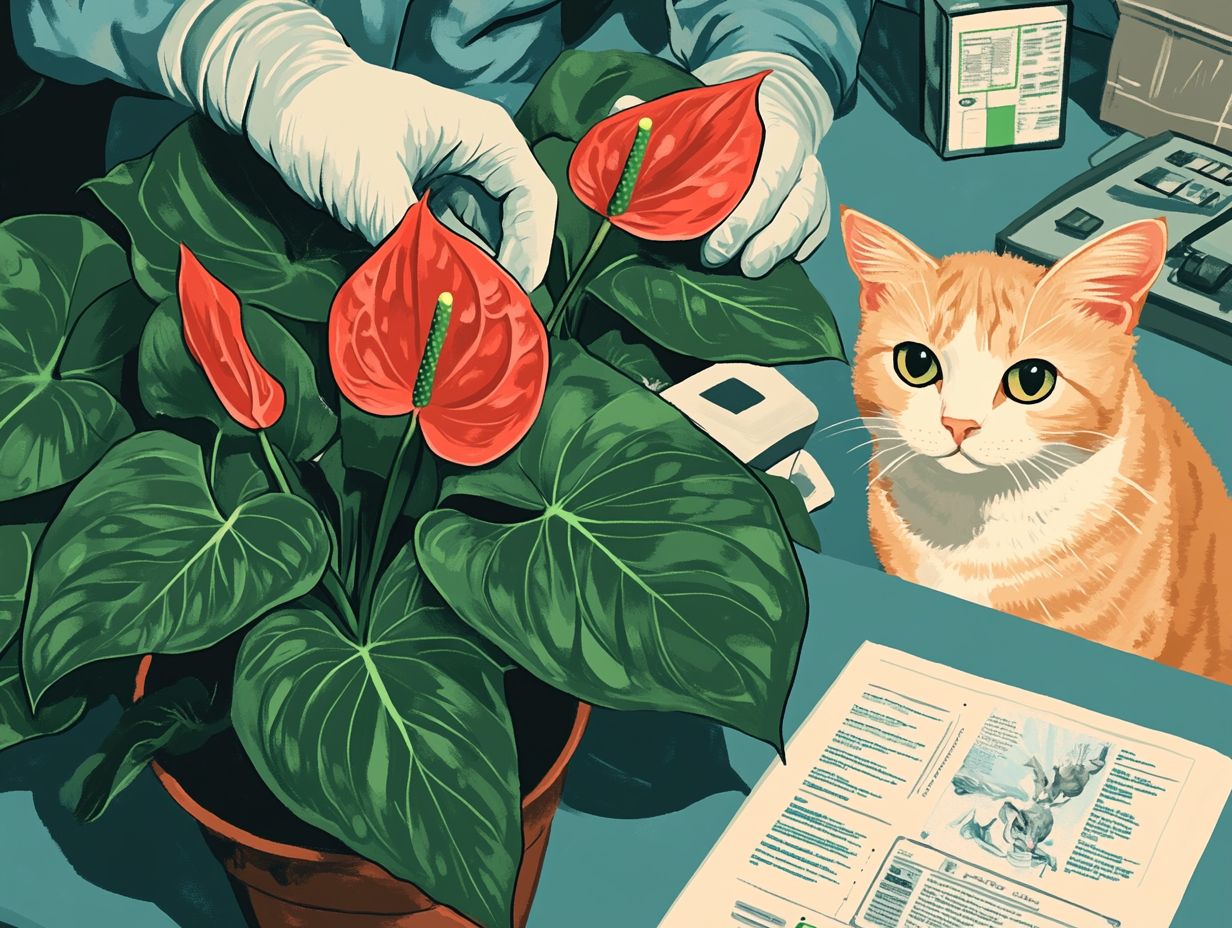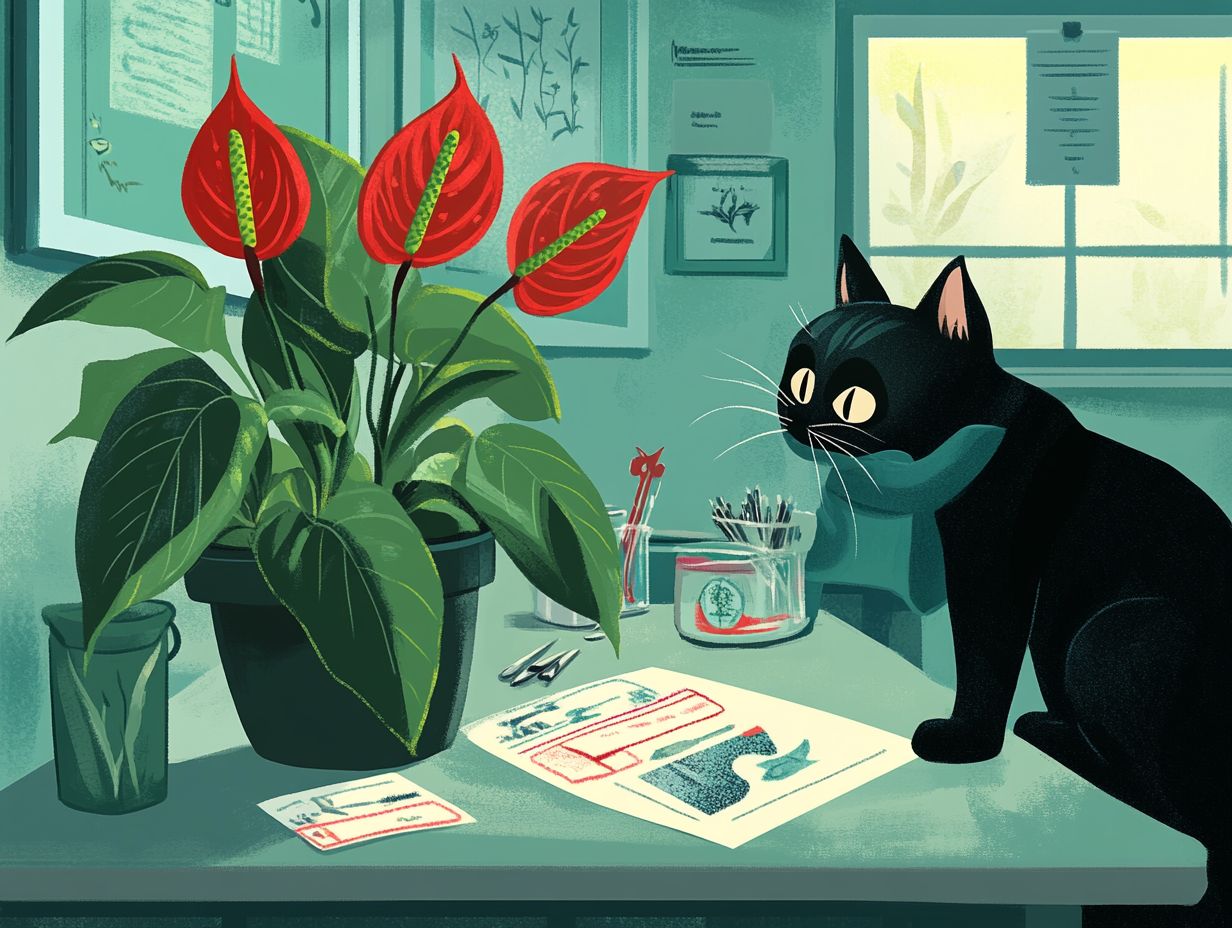Anthurium is toxic to cats, primarily due to the presence of calcium oxalates. These compounds can cause various health issues if ingested, making it crucial for pet owners to understand the risks involved.
Anthuriums are stunning houseplants with their vibrant flowers and glossy leaves, but if you’re a cat owner, you might be wondering about their safety, especially if you have both cats and dogs.
While these tropical plants can enhance your home decor, they may pose risks to your feline friends, as Anthurium species contain calcium oxalates, which are toxic to pets. All parts of the plant, including leaves and stems, are toxic.
This article will explore whether anthuriums are toxic to cats, what to do if your cat ingests one, and how to keep your curious companion safe by employing preventive measures. We will also suggest some cat-friendly plant alternatives. Let’s ensure your home is both beautiful and safe for your furry family member! Following these tips for keeping pets safe and preventing accidents can help maintain a harmonious environment.
Key Takeaways:

- Anthurium can be harmful to cats when ingested, causing gastrointestinal irritation and drooling.
- If your cat ingests Anthurium, monitor for symptoms, contact your vet for professional advice, and induce vomiting if ingestion was recent.
- To prevent ingestion, keep Anthurium out of reach using hanging planters or shelving and provide safe alternatives for your cat to chew on, such as spider plants or calatheas.
What Is Anthurium? Are all Anthurium species the same?
Anthurium, commonly referred to as the Flamingo Lily, is a genus of flowering plants native to the tropical regions of South America, Central America, and the Caribbean. Some popular species include Anthurium andreanum, Anthurium amnicola, Anthurium clarinervium, Anthurium crystallinum, Anthurium faustomirandae, Anthurium hookeri, Anthurium veitchii, and Anthurium watermaliense. These plants are renowned for their vibrant blossoms and glossy leaves.
While Anthurium is a popular houseplant due to its ornamental appeal, it is important to note that some species are toxic to pets because of the calcium oxalates they contain. Therefore, pet owners should be aware of the potential risks associated with having these plants in their homes. Understanding plant care and plant safety is crucial for cat owners with plants.
Is Anthurium Safe for Cats?
Anthurium is harmful to cats and contains toxic properties that can lead to serious health issues if ingested. Cat owners should be aware of the dangers associated with anthurium toxicity, as it can result in oral irritation, vomiting, and difficulty swallowing.
What Are the Potential Dangers of Anthurium for Cats?
Anthurium poses potential dangers to cats, as it is toxic and can lead to serious medical complications if ingested. Symptoms of Anthurium toxicity may include:
- Mild: Oral irritation, drooling
- Moderate: Vomiting, difficulty swallowing
- Severe: Swelling, excessive drooling, changes in appetite
It is essential for all cat owners to be aware of these risks to ensure their cats remain safe and healthy around houseplants. Other signs of toxicity may include excessive drooling, difficulty swallowing, and changes in appetite, all of which indicate the plant’s harmful effects.
If a cat does consume Anthurium, it is crucial to consult a veterinarian immediately, as a prompt response can prevent serious complications. The risks associated with this plant highlight the importance of diligence and awareness in pet ownership. Simple precautions, such as keeping potentially dangerous plants out of reach or opting for non-toxic alternatives, can help safeguard a cat’s health and alleviate concerns about accidental ingestion.
What Should You Do If Your Cat Ingests Anthurium?
If your cat has ingested Anthurium, the first and most crucial step is to promptly mitigate the toxic effects of the plant. Begin by observing your cat for symptoms of toxicity, such as vomiting, drooling, or difficulty swallowing, as these may indicate the need for urgent medical attention. Keeping kitties safe is vital, and being aware of symptoms toxicity is a key part of responsible pet ownership.
Next, contact your veterinarian for specific guidance on the appropriate steps to take, ensuring that your pet receives the necessary care and treatment to minimize the risk of further complications. Consulting PangoVet or another trusted vet service can help you get immediate assistance.
Step-by-Step First Aid Instructions:
- Observe your cat for any symptoms of toxicity.
- Contact your veterinarian immediately for specific advice.
- Do not induce vomiting unless directed by your vet.
- Provide a safe environment and remove access to the plant.
- Follow your vet’s instructions for further care.
Common Misconceptions:
There is a common belief that Anthuriums are safe if only a small amount is ingested. However, even small amounts can lead to adverse health effects, making it crucial to treat any ingestion seriously.
Special Considerations:
Particular populations of cats, such as kittens, senior cats, or those with pre-existing health conditions, may be at a higher risk if they ingest Anthurium. Extra caution should be exercised with these groups to ensure their safety.
Disclaimer: This article is not a substitute for professional veterinary advice. Always consult your veterinarian regarding any health concerns for your pets.
Last Reviewed: [Insert Last Review Date Here]
Anthurium is toxic to cats, particularly its leaves and flowers. The plant contains harmful compounds known as calcium oxalate crystals, which can lead to various symptoms if ingested. It’s essential for pet owners to be aware of these dangers.
Symptoms of Anthurium Poisoning
Symptoms may vary in severity:
- Mild Symptoms: Oral irritation, drooling
- Moderate Symptoms: Vomiting, gastrointestinal upset
- Severe Symptoms: Difficulty swallowing, difficulty breathing, vocalization, lethargy, hiding
Recognizing these signs early can be crucial for your cat’s health.
If your cat becomes less active and playful, it may be feeling unwell. Lethargy, hiding, and decreased appetite can signal several illnesses in pets.
Quick recognition of your pet’s reaction to these plants can be crucial. It may determine whether the issue is easily resolved or a serious medical concern. Always consult a veterinarian if you suspect any signs of toxicity in your pet, and ensure they receive appropriate treatment as soon as possible.
2. Contact Your Veterinarian

If you suspect that your cat has ingested Anthurium, it is crucial to contact your veterinarian immediately. Receiving professional advice as soon as possible can significantly reduce the risks associated with plant toxicity. A veterinarian can evaluate the severity of the situation based on the symptoms exhibited and may recommend treatments tailored to the needs of the affected cat.
When speaking with the veterinarian, it is important to communicate any symptoms you have observed, such as oral irritation, drooling, or gastrointestinal upset. Providing the veterinarian with your pet’s medical history, including any pre-existing conditions and medications, will greatly assist in their assessment.
They may suggest immediate treatments, such as administering activated charcoal to reduce toxin absorption or providing intravenous fluids to help rehydrate and stabilize your cat. Understanding the importance of these treatments is essential for effectively managing toxicity and ensuring that your cat can recover fully in the shortest possible time.
3. Induce Vomiting (If Ingestion Was Recent)
If your cat has recently ingested Anthurium, inducing vomiting may be necessary to limit further absorption of the toxic substance. However, this should only be done under the guidance of a veterinarian, as improper methods can cause additional harm and worsen your cat’s condition.
Veterinarians can accurately assess the situation by considering how much was ingested and when it occurred, and they can recommend safer alternatives for reducing toxin absorption, such as activated charcoal or supportive care to help your pet recover. Vomiting should only be induced by a veterinarian or after consulting one.
Attempting to induce vomiting at home can lead to complications, including aspiration pneumonia or esophageal burns. Therefore, calling your veterinarian should always be the first step if your cat consumes Anthurium to ensure they receive the appropriate care.
How Can You Prevent Your Cat from Ingesting Anthurium?
The most effective way to prevent cats from consuming Anthurium is to keep the plant out of their reach and to educate yourself about which houseplants are safe for cats. Common non-toxic alternatives include spider plants, Boston ferns, and cat grass. Implementing plant room strategies can minimize risks and help in preventing plant ingestion.
Implementing consistent and effective prevention measures is crucial to ensuring your cat’s safety from the dangers posed by Anthurium and other toxic household plants.
1. Keep Anthurium Out of Reach
One of the most effective preventative measures for ensuring cat safety is securely positioning Anthurium plants to prevent accidental ingestion. This involves placing them on high shelves or in areas that inquisitive cats cannot reach. By ensuring plant safety for cats, you can enjoy your houseplants without the worry that they may pose a risk to your furry friends.
Using hanging planters is an excellent option, as they not only elevate plants but also add an interesting design element to your home. Closed terrariums are another smart choice; they create a small contained ecosystem that is visually appealing while minimizing the chance of curious paws making contact. These preventive measures can go a long way in keeping pets safe and ensuring plant safety.
Regularly inspecting plants and their surrounding areas is essential for maintaining a safe environment. Promptly removing fallen leaves and debris minimizes the risk of ingestion, providing peace of mind for plant lovers who share their homes with cats.
2. Provide Safe Alternatives for Your Cat to Chew On
Offering your cat safe plants, such as cat grass or catnip, can deter them from chewing on harmful plants like Anthurium. Ensure these alternatives are easily accessible.
Common Misconceptions About Anthurium
Many pet owners believe that Anthurium is safe for pets. This myth can lead to accidental poisoning. Always research plants before bringing them into your home.
Emergency Contact Information
If you suspect your cat has ingested Anthurium or shows signs of poisoning, contact:
- ASPCA Animal Poison Control: (888) 426-4435
- Your local veterinarian
Disclaimer: Always consult with your veterinarian for personalized advice and ensure you adhere to legal considerations regarding medical claims.
Providing safe alternatives for your cat to chew is a proactive measure to prevent them from being attracted to potentially toxic plants, such as Anthurium. Selecting non-toxic houseplants, like cat grass or spider plants, can satisfy your cat’s natural urge to chew while ensuring their safety and health. These tips for keeping pets away from harmful plants are essential for any pet-friendly household.
This approach not only protects your pets but also fosters a harmonious environment with your plants. You can easily incorporate these plants into your home by placing pots in sunny locations that are accessible to your cats.
Along with cat grass and spider plants, Boston ferns and bamboo palms are other houseplants that can thrive indoors without posing a risk to curious cats. These non-toxic houseplants can enrich any indoor plant collection while ensuring cat health and safety.
Enrichment is crucial for keeping cats engaged, so providing scratching posts, toys, and opportunities for interactive play can help divert their attention from your houseplants. By creating a stimulating environment, cat owners can effectively keep their pets away from potentially harmful plants, ensuring that their living space is safe and enjoyable for everyone. Understanding plant care and cat health can help in keeping kitties safe.
What Are Some Cat-Safe Alternatives to Anthurium?
There are many non-toxic Anthurium alternatives that can enhance your home while ensuring the safety of cats. Opting for non-toxic indoor plants not only creates a safe environment but also offers a variety of aesthetically pleasing options to enrich any indoor plant collection.
1. Spider Plant (Non-toxic)

The spider plant is a popular houseplant among cat owners due to its non-toxic nature, making it a safe addition to any home. This hardy plant enhances interior spaces with its attractive green and white leaves while providing a safe option for cats that enjoy nibbling on greenery. Symptoms of mild gastrointestinal upset may occur if cats overindulge, but spider plants are generally safe.
Additionally, the spider plant is well-known for its air-purifying abilities, making it an excellent choice for improving indoor air quality. By removing common indoor pollutants, it contributes to a healthier environment for both pets and people.
The spider plant requires minimal care, needing only occasional watering and indirect sunlight, allowing anyone to enjoy its presence without the burden of high maintenance. Its ability to thrive in various light conditions further establishes it as an ideal pet-friendly houseplant.
2. Calathea (Non-toxic)
Calathea is a cat-safe houseplant that adds vibrant colors and patterns to your indoor space, ensuring the safety of your feline companions. Renowned for its striking foliage and unique leaf movements, calathea is not only visually appealing but also non-toxic to cats, making it a worry-free addition to your home. Although non-toxic, ingestion of large quantities could lead to mild digestive upset.
With numerous varieties available, each calathea showcases its own distinct charm, ranging from the bold, round leaves of Calathea orbifolia to the intricate patterns of the Calathea medallion. These plants thrive in humid conditions, making them ideal for plant rooms where they can flourish alongside other species. If you’re also considering other houseplants and their safety, you might want to check if Anthurium is harmful to cats.
Their unique behavior of closing leaves at night and opening them during the day creates a dynamic aesthetic that captivates the eye. To care for these beautiful companions, it is essential to maintain the right balance of moisture and provide indirect light, enhancing their beauty while ensuring they remain safe for curious pets. For more information on whether these plants are safe for your furry friends, check out the vet’s analysis on Anthurium safety for cats.
3. African Violet (Non-toxic)
African violets are non-toxic houseplants for cats, featuring vibrant blooms that make them an appealing decorative choice. Unlike plants such as Anthurium, African violets have low toxicity levels, ensuring safety for pets. Their bright colors and soft leaves enhance their ornamental appeal, although they could cause mild gastrointestinal upset if consumed in large amounts.
To thrive, African violets require bright, indirect light, making a north or east-facing window ideal for their growth. They need consistent moisture, as overwatering can lead to root rot, while excessive drying may cause wilting and stress to the plant.
First Aid for Plant Ingestion: If you suspect your cat has ingested any part of a plant, monitor for symptoms like vomiting or diarrhea. Consult your veterinarian immediately for tailored advice.
Legal Disclaimer: The content of this article is not a substitute for professional veterinary advice. Always consult your veterinarian for specific concerns regarding your pet’s health.
Emergency Contacts: For immediate assistance, contact the ASPCA Poison Control at (888) 426-4435.
This content will be reviewed and updated every six months to reflect the most current research on plant safety for cats.
Pet lovers can easily integrate these flowering plants into their homes by placing them on high surfaces or shelves, as they are resilient enough to withstand the curious nature of cats. Additionally, the low upkeep required for their care makes African violets a desirable option for many.
4. Boston Fern
Boston ferns are beautiful, non-toxic houseplants that can enliven any room and are safe for cats. Toxicity Level: Non-toxic. These hardy plants thrive in bright, indirect sunlight and are recognized for their arching fronds, contributing to their aesthetic appeal. They are also effective at purifying the air in their surroundings.
Symptoms of Ingestion: While Boston ferns are non-toxic, ingestion may lead to minor gastrointestinal upset. If you suspect your cat has eaten a Boston fern, monitor for any unusual behavior.
Boston ferns prefer high humidity, so regular misting or placing them near a humidifier can help maintain their vibrant appearance. Along with their decorative qualities, they have been shown to filter toxins from the air.
5. Christmas Cactus
The Christmas cactus is a beautiful, non-toxic plant that is safe for cats. Toxicity Level: Non-toxic. This hardy succulent produces stunning blooms during the holiday season and requires relatively low maintenance, making it an ideal choice for pet owners who want to keep their cats safe. For more information on plant safety, check out Is Anthurium Harmful to Cats? A Vet’s Plant Safety Analysis.
Symptoms of Ingestion: Although the Christmas cactus is non-toxic, ingestion can lead to mild digestive upset, so keep an eye on your cat if they consume any part of it.
The Christmas cactus thrives in bright, indirect sunlight and should be watered only when the soil is dry, avoiding conditions that are either bone dry or saturated. When cared for properly, this succulent can continue to produce its lovely flowers year after year.
Watering is optimal when the top inch of soil is dry, as this helps prevent the stress of overwatering. While the Christmas cactus does not need frequent fertilization, it can benefit from being fertilized once every two weeks during the growing seasons of spring and summer.
Overall, the Christmas cactus is a wonderful addition to any holiday atmosphere and is a safe option for homes with pets, offering a better choice than plants like Anthurium.
Frequently Asked Questions
Is Anthurium harmful to cats?

Yes, Anthurium can be harmful to cats if ingested. Toxicity Level: Toxic. The plant contains insoluble calcium oxalate crystals which can cause irritation and discomfort in cats’ mouths and digestive systems. It is important to keep Anthurium plants out of reach of cats.
What should I do if my cat ingests Anthurium?
- Stay calm and assess the situation.
- Contact your veterinarian or the ASPCA Animal Poison Control.
- Do not induce vomiting unless instructed to do so by a veterinarian.
- Monitor your cat for symptoms like drooling, vomiting, or difficulty swallowing.
- Provide the veterinarian with any information about the amount ingested and your cat’s health history.
What are the symptoms of Anthurium poisoning in cats?
The symptoms of Anthurium poisoning in cats include drooling, difficulty swallowing, vomiting, and in severe cases, difficulty breathing. If you suspect your cat has ingested Anthurium, seek veterinary care immediately.
Are all parts of the Anthurium plant toxic to cats?
Yes, all parts of the Anthurium plant, including the leaves, stems, and flowers, are toxic to cats. Even small amounts can cause harm to your feline friend.
Can I have Anthurium in my home if I have cats?
It is not recommended to have Anthurium plants in your home if you have cats. Even if the plant is placed out of reach, cats are curious creatures and may still find a way to ingest the plant.
What are some safe alternatives to Anthurium for cat owners?
If you are a cat owner and want to have plants in your home, there are many safe alternatives to Anthurium. Some non-toxic houseplants for cats include spider plants, African violets, and Christmas cacti.
Common Misconceptions: Many people believe that all green plants are safe for cats. This is not true. Always research specific plants before bringing them into your home.
Special Considerations: Be cautious with kittens and senior cats, as they may be more prone to digestive upset from any plant ingestion, even non-toxic varieties.
Expert Input: “It’s crucial to know which plants are safe and which are not to prevent any health issues in our pets,” says Dr. Jane Smith, Veterinarian.
Emergency Contact: Keep a list of toxic vs. non-toxic plants handy and save the number for the ASPCA Animal Poison Control (1-888-426-4435).
Last reviewed: October 2023. Content will be updated regularly based on emerging research.